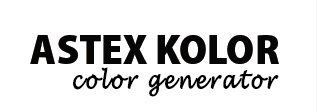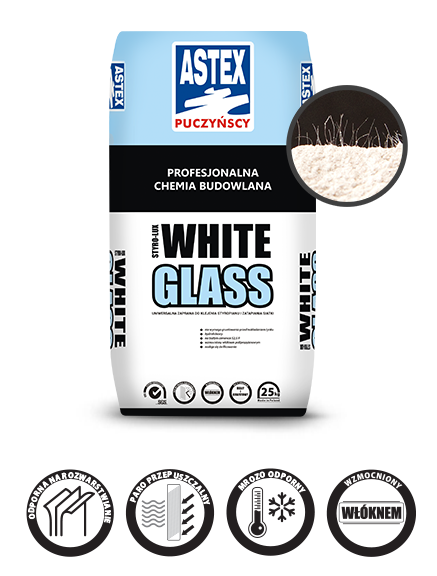Adhesive mortar for embedding mesh and sticking styrofoam boards STYRO LUX white White Glass
White Glass adhesive mortar is intended for gluing and filling foamed polystyrene boards and for embedding fiberglass mesh in the reinforced layer of the ASTEX TERM insulation system
- Does not require priming before applying the plaster
- Hydrophobic
- Produced from 52.5R white cement and sand used for glass production
- Reinforced with polypropylene fiber
Calculate expenditure
Sticking foamed polystyrene
Mesh embedding
Przyklejanie styropianiu
Zatapianie siatki
Expenditure when gluing foamed polystyrene boards
4,0-5,0 kg/m2
Expenditure on embedding mesh
3,0 -4,0 kg/m2
Shell life
12 months from the date of production
Packaging
25 kg
Number of packages on a pallet
54 pcs
Reference document
European Technical Assessment 17/0726
Application
White Glass adhesive mortar is used to glue boards of white, graphite and hydrophobic polystyrene in a thermal insulation system for various types of decorative plasters. The mortar is suitable for filling cavities of the stabilized substrate, as well as for leveling surfaces, e.g. for gluing ceramic tiles. Can be used inside and outside buildings.
Properties
White Glass is a universal and hydrophobic adhesive mortar designed for gluing foamed polystyrene boards and for embedding mesh. White Glass mortar is produced from 52.5R white cement and is additionally reinforced with polypropylene fiber, thanks to which it is characterized by increased resistance to mechanical damage. Special additives ensure the hydrophobicity of the mortar, thanks to which a coating is created, on which façade plaster can be applied directly without using concealed primers. The condition of this technology is continuity of work. If the facade is covered with White Glass mortar and is left to weather conditions for more than 3 months, then before laying the plaster, the surface should be primed with Akro-Primer-U or Akro Grunt SiSi. Warunkiem tej technologii jest ciągłość prac. Jeżeli elewacja zostanie pokryta zaprawą White Glass i zostanie pozostawiona na warunki atmosferyczne dłużej niż 3 miesiące, to przed położeniem tynku należy zagruntować powierzchnię preparatem gruntujący Akro Grunt-U lub Akro Grunt SiSi.
Substrate preparation
The substrate should be dry, stable, even and carrying, i.e. strong enough, cleaned of layers that can weaken mortar adhesion (dust, dirt, oils, fats, wax, oil and emulsion paint residues). Substrate unevenness greater than 15 mm, which prevents the application of the correct thickness of White Glass adhesive mortar, should be corrected using materials recommended for this type of work. Excessive absorbency of the substrate should be reduced by using UNI-ASTEX priming emulsion.
Mortar preparation
Pour the contents of the package into a measured amount of water from about 5.5 to 6l per 25 kg and mix with a low-speed mixer until a homogeneous mass without lumps is obtained. Wait about 5 minutes and mix again. If necessary, add a small amount of water and mix again.
Gluing of foam boards
Spread the mortar using a strip-point method on a foamed polystyrene board using a trowel. The thickness of the applied mortar layer depends on the evenness of the substrate and it should be selected so that after application it covers a minimum of 40% of the panel surface, and after pressing the panel against the wall a minimum of 60%
Making a reinforcement layer on a fiberglass mesh
Spread White Glass adhesive mortar on the surface of the plate with a notched trowel, then plunge the fiberglass mesh into it, remembering 10 cm overlaps at the junction of the mesh strands. The thickness of the mortar layer should be min. 3 mm, and the plunged mesh should be at half thickness of the first layer of mortar. The setting time of the mortar depends on weather conditions, but it can be assumed that it is about 24 hours per 1 mm of mortar thickness. During drying, the mortar should be protected from adverse weather conditions such as rain, frost, gusty wind, direct sunlight. During work and when setting the mortar, the substrate and air temperature should be between + 5 ° C and + 25 ° C.
Temperature of performed work
Air temperature from + 5 ° C to +25 ° C. Substrate temperature from + 5 ° C to +25 ° C. Work in temperature between +5 ° C and +25 ° C. For a period of 7 days after the completion of works, the air temperature should not be below +5 ° C, and for the next 21 days should not fall below 0 ° C.
Expenditure
Bonding of foamed polystyrene boards approx. 4.0-5.0 kg per 1m², Embedding fiberglass mesh: 3.0-4.0 kg per 1m².
Storage and transport
The products must be absolutely stored in undamaged packaging and dry rooms on pallets. Protect from moisture, getting wet during storage and transport. The storage period of the product in conditions complying with the recommendations given is up to 12 months from the date of production placed on the packaging in digital print. The date of production, which is placed on the packaging, is also the date of manufacture of the product. Any changes visible in the product or packaging structure without special tests, in particular discoloration or smudging of the packaging graphic, infringements of the packaging continuity, biological changes in the product structure, recognizable in particular as a consequence of moisture, may indicate poor storage or transport conditions and do not guarantee compliance declared performance characteristics of products as specified.
Packaging
25 kg paper bags
Precautions
The product contains cement which, when mixed with water, gives an alkaline reaction. Take measures to prevent dusting or splashing with the mortar. Do not inhale, protect eyes and skin. In case of contamination: rinse eyes immediately with plenty of clean water and seek medical advice, wash skin with soap and water. Keep out of children's reach. If swallowed, seek medical advice immediately and show the container or label.
Do you have questions? Doubts? Ask an advisor Contact form













